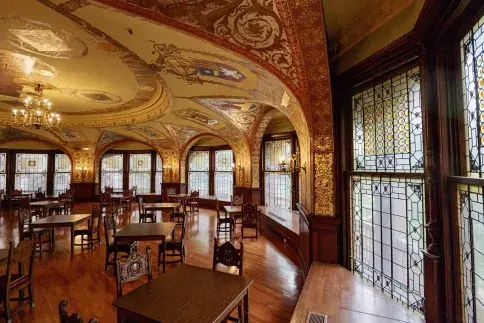Look Up
Decoding D-Hall: Mysticism on the Menu

If you're sitting in the rounded alcoves of the Dining Hall, search the skies. Do you see your astrological sign?
Mysticism on the Menu: East Alcove
East Alcove
Three squares hover overhead. Pisces stands alone. The other two represent pairs of astrological signs: Capricorn with Aries and Gemini with Taurus. Do you recognize them?
Pisces
While you may be more familiar with the two fish posed in a circle, Pisces is shown here as a female figure riding atop two leashed fish. This image alludes to ancient tales from Greece, Rome, and Syria. In one version of the story, told by the Roman poet Ovid, the goddess Dione (Venus) and her son, Jupiter, escape a monster with the help of twin fish that carry them on their backs.
Pisces was the sign of the artistic hand behind these murals—George Maynard [link to bio]. Astrologers say Pisces are creative, intuitive, and empathetic. Other famous Pisces visual artists include Michelangelo, Peit Mondrian, Pierre-Auguste Renoir, Diane Arbus, and Kehinde Wiley.
Capricorn and Aries
At the center, you'll see a square with two animal head silhouettes surrounded by an array of ribbon-like scrolls. This represents Capricorn, the goat, and Aries, the ram. In Greek mythology, Capricorn is associated with the goat Amalthea, who nursed Zeus, and whose broken horn became the magical cornucopia, or horn of plenty. What a great symbol for the feasts that took place down below!
And the mastermind behind those feasts, none other than Henry Flagler, was a Capricorn! Astrologers regard Capricorns as smart, hardworking, determined, and loyal. On the downside, they may be super stubborn. Henry may well be the perfect example of a Capricorn. He built an empire and pursued his interests relentlessly, and if you stood in his way, prepare to face the consequences!
Gemini and Taurus
Come back another time when we reveal the secrets of this third square!
Want more?
Next time you're in D-hall, sit on the West side to discover its signs and symbols.
Mysticism on the Menu: West Alcove
West Alcove
Say hello to Sagittarius and Scorpio, Cancer, and Leo.
Cancer
Cancer is depicted by a crab. Ida Alice Shourds Flagler, Henry's wife when he built the hotel, was a Cancer. While Capricorn and Cancer are opposing astrological signs, they are said to be able to forge a strong bond despite their differences. Ida stood by Flagler through a significant phase in his career as he forged his railroad through Florida. After nearly two decades, their marriage ended in divorce. Was her water sign just too deep for his grounded earth one?
Leo, Sagittarius, and Scorpio to come!
Want more?
Next time you're in D-hall, sit on the East side to discover its signs and symbols.
Brief History of Astrology
Brief History of Astrology
Western astrology dates back to a second-century text, the Tetrabiblios, written by Claudius Ptolemy. He recorded the system he observed around the Mediterranean Basin, rooted in Hellenistic, Egyptian, and Babylonian traditions. Ptolemy is well-known today as a great Greco-Roman scientist who first proposed that the Earth was at the center of our solar system. Astrology remained a part of the scientific world for centuries. The famous astrologer Galileo Galilei actually served as court astrologer to the Medici!
In Christianity, astrology fell out of favor chiefly for its predictions. Assuming humans could know what God would do was heretical. In the fourth century, St. Augustine argued against it, saying it contradicted the idea of free will given to humans in the Bible, though he had leaned into it earlier in his life, stating it was more scientific than other kinds of divination.
So why would Henry Flagler, the son of a Presbyterian minister and a devout Christian, place these symbols on his ceilings?
It may connect with the medieval king of Castile, León, and Galicia in the latter part of the thirteenth century, Alfonso X the Wise. (Did you catch that "Leon" connection?) Alfonso supported the work of two Jewish translators, Yehuda ben Moshi ha-Kohen and Isaac ibn Sid, to publish various works on the stars and astrological ideas combining Ptolemy's concepts with Islamic astrology, particularly the work of Abu al-Hassan Ali Ibn Ali Ibn Abi al-Rijal, a Tunisian court astrologer in the eleventh century. This text spread throughout medieval and Renaissance Europe. The illustrations done at the time of Alfonso bear striking similarities to those you see above you today.
When Flagler ordered a hotel in a romantic Spanish style, Maynard likely found these elements authentic and interesting. After all, the hotel was named after explorer Ponce de Leon, who was from the Leon region where Alfonso X had supported intellectual curiosity across cultures and languages. (He may even be a direct descendant! One historian thinks the surname de Leon began with an illegitimate daughter of Alfonso X's grandfather.)
Spiritualism was a growing fad in Gilded Age America, along with the aesthetic for historical, romantic, and exotic art and architecture to which the Ponce aspired. Perhaps Flagler saw the design as more en vogue than heretical. As for Maynard, the astrological signs brought to America one of the many wonderful mural elements he had studied for so long while traveling in Europe. His murals and paintings were often allegorical and almost always featured some form of symbolism rooted in mythology or celestial figures.
Fun Fact
The word zodiac means "circle of little animals," referring to the symbols associated with each astrological sign. It refers to the belt in the sky through which the sun, moon, and planets move throughout the year.